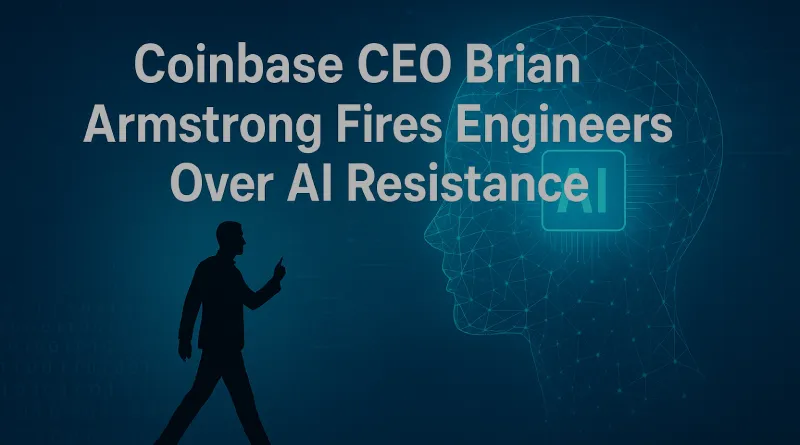Coinbase CEO Brian Armstrong Fires Engineers Over AI Resistance: A Bold Move in Tech’s AI Revolution
In a shocking move that shows how quickly the tech industry is moving toward AI, Coinbase CEO Brian Armstrong fired engineers who wouldn’t use AI-powered coding tools like GitHub Copilot and Cursor. This made news. Armstrong talked about his “rogue” way of forcing engineers to use AI on the Cheeky Pint show with Stripe co-founder John Collison. He said that he gave engineers one week to get on board or face a meeting on Saturday to explain why they weren’t. People who didn’t have a good reason, like being on vacation, were fired. This piece uses reliable sources like Fortune and LiveMint to talk about Coinbase’s aggressive AI strategy, what it means for the workforce, and how it fits into India’s growing tech scene.
The Mandate: AI or Out
The biggest cryptocurrency exchange in the U.S., Coinbase, which is worth $77 billion, bought business licenses for AI coding assistants to make things run more smoothly. Armstrong didn’t agree with the time frame given when he was told that adoption could take months to hit 50%. “I went off the rails,” he wrote in Coinbase’s engineering Slack group. “AI’s important.” Everyone needs to learn it and be on board by the end of the week. Noncompliance led to a meeting on Saturday, where some engineers were fired for not having good reasons. Fortune says that even though the exact number of layoffs has not been made public, the move made it clear that AI is not an option at Coinbase.
Armstrong admitted that this “heavy-handed” method was criticized within the company, but it was in line with his goal of having 50% of code generated by AI by Q3 2025. 33% of Coinbase’s code is written by AI right now. This is made possible by monthly “AI Speed Runs,” where the best teams share their best ideas. Armstrong stressed the need for human control, especially in financial systems, saying, “You don’t want people vibe-coding systems moving money.” This mix shows a cautious but aggressive acceptance of AI, putting both new ideas and dependability first.

Local Context: India’s AI Adoption Race
In India, where more than 5.4 million people work in the tech industry and it makes up 8% of the country’s GDP (NASSCOM 2025), Armstrong’s choice makes sense. A McKinsey study says that 67% of Indian companies plan to invest in AI by 2026. This is because Bengaluru and Hyderabad, two of the country’s IT hubs, are racing to add AI. Finance Minister Nirmala Sitharaman talked about how AI can help India’s economy grow to $5 trillion, saying that it could add $500 billion to GDP by 2030. This is also true for Coinbase’s operations in India, which are supported by its 2024 FIU registration (Indian Express). Local engineers are expected to be given similar AI tasks.
But India’s workers have their own problems to deal with. There is a difference between the generations, as shown by the fact that 49% of Indian middle managers want to learn more about AI, while only 41% of younger workers want to do the same. In a place where 1.4 million tech jobs could be automated by 2025 (World Bank), Armstrong’s firings show a harsh truth: change or become obsolete. Indian developers, especially those working in fintech, need to figure out how to deal with this change while balancing AI’s speed with the need for safe, human-reviewed code in a crypto-driven market like India, where 100 million people hold $10 billion in digital assets (Chainalysis 2025).
Unique Insights: The Double-Edged Sword of AI Mandates
Armstrong’s method is brave, but it makes me wonder about workplace autonomy and the reliability of AI. LiveMint says that Collison from Stripe asked Armstrong how to handle a codebase that was written by AI, and Armstrong agreed, pointing out that there could be risks. Interesting fact: If engineers are afraid to try new things because of strict rules, requiring AI to be used quickly may stop creativity. Seventy percent of coders in India use AI tools, but less trust has grown in their accuracy (Stack Overflow 2025). This could make people more cautious when they code, which would hurt creativity in a field known for being quick on its feet.
The firings also show a change in culture. In India’s joint tech workplaces, skill development is usually slow. Coinbase’s ultimatum, on the other hand, is more in line with the “move fast” mentality of Silicon Valley. Indian companies like TCS and Infosys, which have 1 million coders working for them, may offer training instead of firing workers because of the country’s labor rules and the power of unions (Economic Times 2025).
Broader Implications and What’s Next
Coinbase’s plan fits with global trends, as tech giants like Microsoft and Google require the use of AI (Business Today). According to a poll on GitHub, 92% of U.S. programmers use AI tools and 70% say they make them more productive. This suggests that Armstrong’s push is based on reality. Still, Collison’s doubts and those of Indian developers on platforms like X (@positonic, 2025-08-25) show how important it is to have strong code review processes.
Upskilling is very important for Indian workers. Sites like Coursera say that the number of people taking AI classes in India has grown by 40% since 2024. Coinbase’s monthly training events could be used as an example by other companies in the area to encourage learning by doing. As the industry changes, engineers must carefully adopt AI, finding a balance between speed and safety so that they can do well in a future dominated by AI.
Disclaimer
The information presented in this blog is derived from publicly available sources for general use, including any cited references. While we strive to mention credible sources whenever possible, Web Techneeq – Web Design Agency in Mumbai does not guarantee the accuracy of the information provided in any way. This article is intended solely for general informational purposes. It should be understood that it does not constitute legal advice and does not aim to serve as such. If any individual(s) make decisions based on the information in this article without verifying the facts, we explicitly reject any liability that may arise as a result. We recommend that readers seek separate guidance regarding any specific information provided here.

